Croatia Wine: ”Every Visit Is A Voyage Of Discovery”
August 9, 2020 - Meet Marc Hough, a former international DJ who became a wine importer after visiting Dubrovnik and trying Croatia wine. In 2020, he returns for his 20th summer.
Situated in the north of England, about halfway up the island called Great Britain, the city of Manchester is famous for its football and music. Mancunians are proud of this. Two members of TCN are from the city, and when someone local asks “Odakle si?”, usually we say “Ja sam iz Manchestera” (I am from Manchester). We don't say "I'm from England" or "Great Britain". Everyone knows where Manchester is.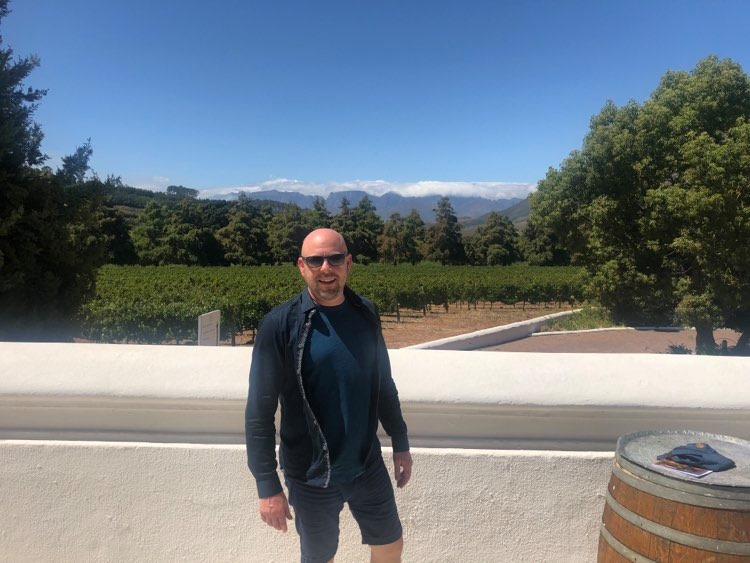
Marc Hough, a former international DJ. His passion for the Plavac he discovered in Dubrovnik turned him into a wine merchant.
20 years ago, Marc Hough was a high profile member of Manchester's famous music scene. He counts members of bands like The Stone Roses and The Happy Mondays as close personal friends. As longstanding DJ to New Order (the band that was once Joy Division), he toured the world playing the music of Manchester to many. But, no more.
“I reached the age of 40 in 2010 and thought, what am I doing with my life?” Hough told TCN over the phone, as he was preparing for a trip Dubrovnik. “DJing and the music business is a young man's game.”
And so, inspired by an enthusiasm for Croatia wine, he turned his back on a high profile DJ career and became a wine bar owner and wine merchant.
One of Marc's 'Cork Of The North' wine bars / stores near Manchester © Cork Of The North
“When I started, I was literally just selling wine out of the back of my car. I only had five customers and three of those were my dad, my brother and me!” remembers Marc, who has built his independent business considerably since then. He is now a wholesaler, recommending and selling wines to top bars and restaurants in the north of England. He has also opened two of his own wine bars 'Cork Of The North' (which are also wine shops), in Sale and Heaton Moor, near Manchester.
“Croatia plays such a big part in the story,” stresses Marc. “I've been visiting Dubrovnik for over 20 years. I had a friend from there who I met in Manchester. She came to live here for a while to escape the war. After it finished, she went home, invited me to Dubrovnik and I just fell in love with the place.”
“There was a wine bar in the Old Town called D'Vino, run by a half Croatian half Australian guy called Saša. After I saw what he was doing there with Croatia wine, I thought that's exactly the kind of place I'd like to have in Manchester.”
Already passionate about wine thanks to his grandad, that first trip to Dubrovnik made Marc curious to return. On his next visit to Croatia, he travelled further than just the Pearl of the Adriatic and went to the source of some Croatia wine itself.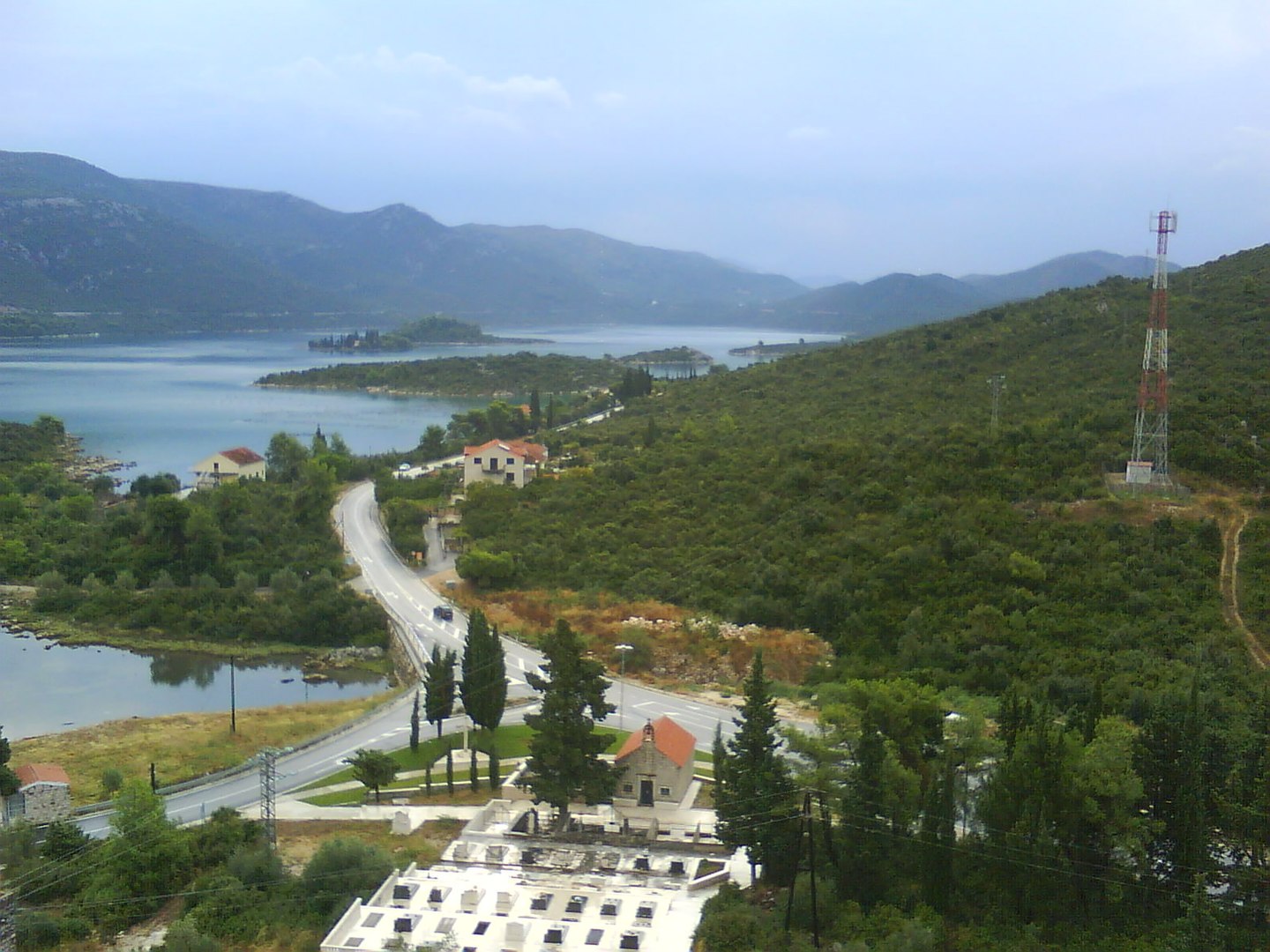
Part of the Pelješac peninsula, which features heavily in Marc's 20-year affair with Croatia wine © Anto
“I came back on a sailing holiday with Bernard Sumner (guitarist of Joy Divison and singer of New Order),” Marc recalls. “He loves sailing and he has his own boat. We went all round Pelješac, Korčula, Brač. I fell in love with Dingač. Since then, I've travelled all of Dalmatia and through Istria learning about the wines. I've been to Bosnia to try their varieties like Vranac. But, for me, the most recent, amazing discovery has been Slavonia. They make some incredible white wines there; Graševina, Cabernet Franc, Traminac.”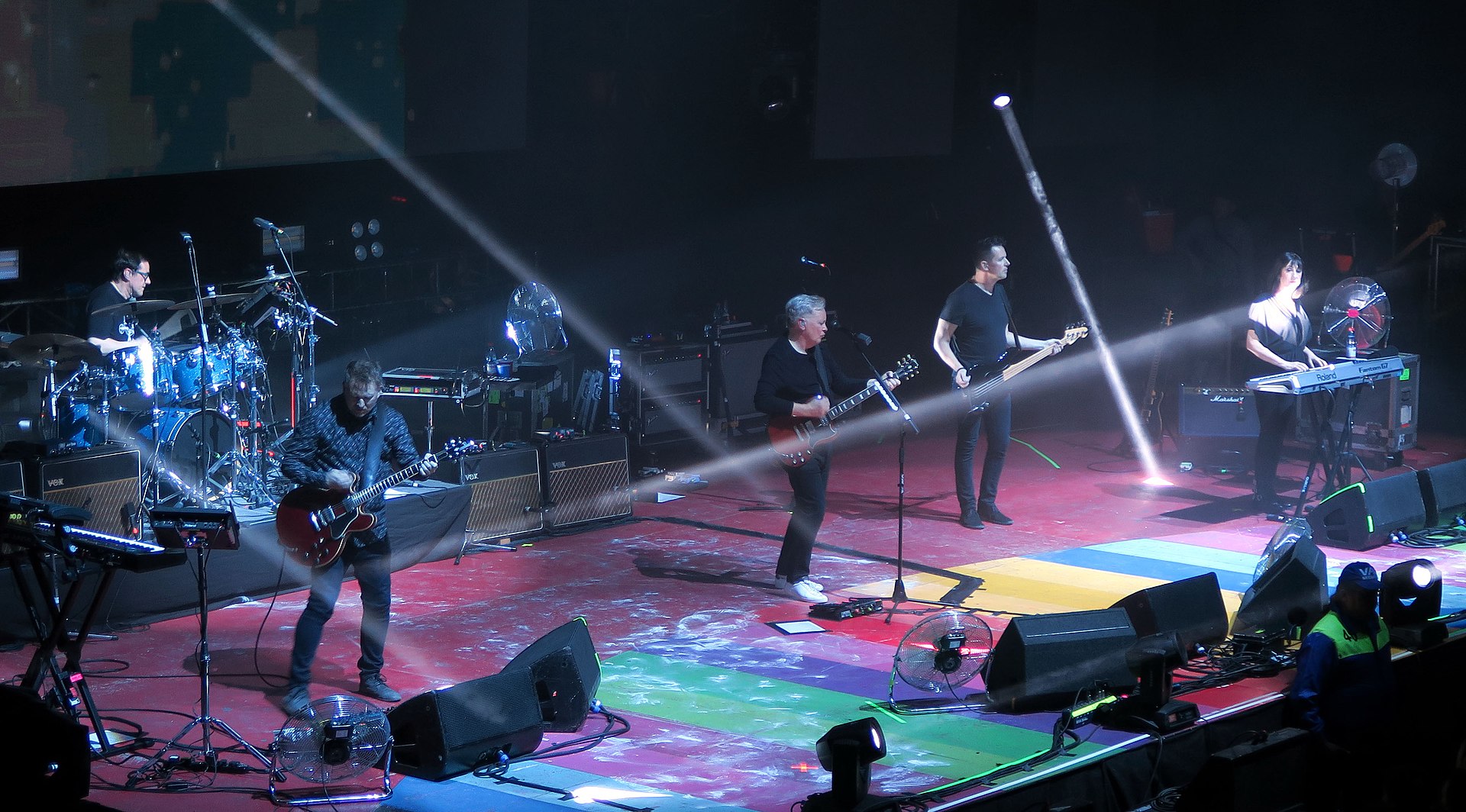
New Order, the band that was once Joy Division. Marc Hough toured the world as their DJ © RL GNZLZ
“For me, it's always half holiday, half work,” Marc tells us, as he packs for his 20th annual trip to Dubrovnik, which begins on Sunday 11 August. “Amazing views, amazing people, amazing food and amazing wine. But, the wine always inspires thoughts of work. I can't help myself. I love visiting the vineyards, meeting the winemakers. It's not the same as when you do it in other countries. In Croatia, you'll often be invited into the kitchen or onto the terrace of the winemaker's home. You'll leave with arms full of different bottles - some gifted - and you can even be sold fine wine unceremoniously in a plastic bottle. I love that informal, homemade feel of the experience. It's charming and honest. When I go on buying trips in France, Spain and Italy, it's rarely like that.”
Dubrovnik's tourist season has this year stalled in response to COVID-19. Its visitors' reliance on charter air and cruise ships has proved inflexible. Yet, a little further up the coast, in Makarska and Omiš, the city centres are now full of families who drive to these places every year. Dubrovnik's offer is more once-in-a-lifetime, less loyalty. Unless, of course, it's the wines and not the walls that call you to Dubrovnik.
“It's inevitable that I'll find something new that I want to bring back with me,” Marc says of his impending trip. “Every visit is a voyage of discovery. This time, although I'll again be based around Dubrovnik, I'm determined to go to Slavonia to look at some Graševina and Cabernet Franc, which thrives in the terroir there.”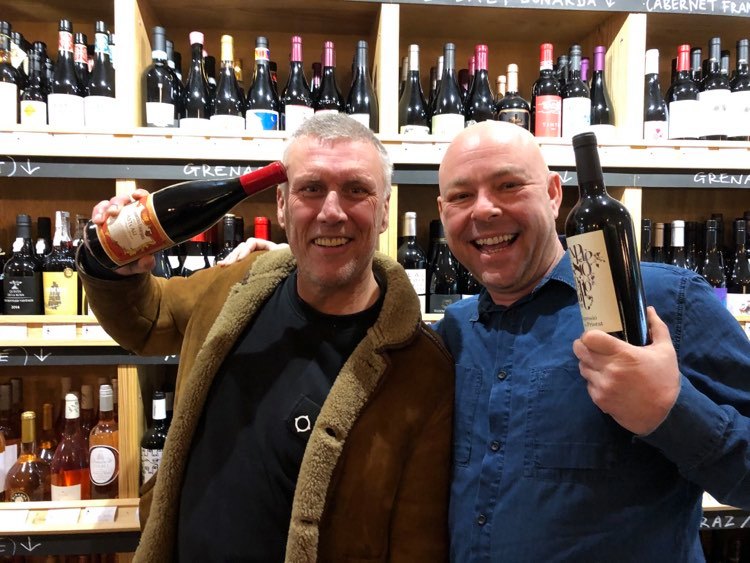
Marc Hough with just one of his famous friends from the Manchester music scene. Bez, of the band Happy Mondays, is now a customer at Cork Of The North © Cork Of The North
“I wanted to start importing Croatia wines years ago but, for someone at my level, it was so difficult before Croatia became a full member of the EU. Tariffs were payable on the borders and if you wanted to move wines from south Dalmatia - Dubrovnik and the islands - you'd have to go through the border with Bosnia. I lost several whole shipments to the Bosnian police, who said my paperwork was incorrect (it wasn't). It's much better these days. But, there's still very little Croatian wine in the UK, even though the interest in Croatia wine is massive. There's a big demand from people who are really passionate about wine, but also people who come back from holiday, have enjoyed Croatian wine, go searching for it, and just can't find it.”
Cork Of The North varies its selection of fine wines throughout the year. At the moment, Marc stocks Kozlović Teran and Kozlović Malvasia from Istria and Septem Pontes Plavac Mali from Pelješac.
“For an independent like me, I buy an export pallet for each wine I want to bring back. That's 600 bottles of each wine.,” he says, “and as my own personal passion right now is for Graševina, I expect at least one of those to be filled with Slavonian wine on this trip.”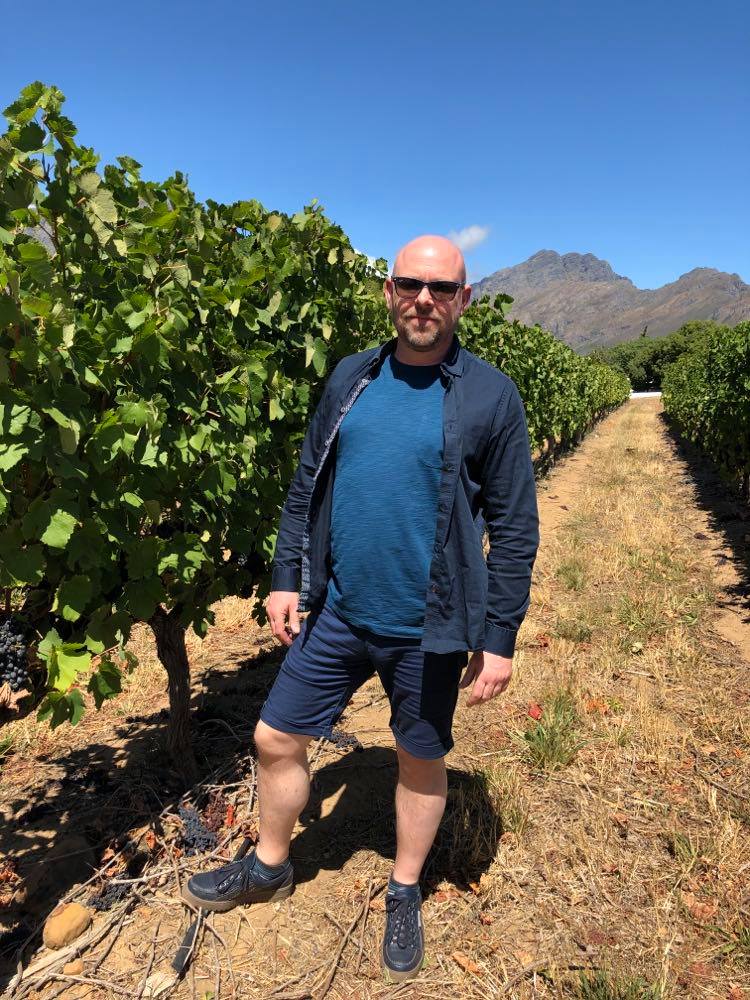
Marc Hough on one of his Croatia wine buying excursions
Croatia's Wine Cellars Full As Sales Plummet
May 29, 2020 — Wine cellars in Croatia are hitting the bottom of the barrel as restaurant orders and guests fall because of the pandemic.
The Croatian Chamber of Commerce said winemakers across the country saw sales plunge up to 80 percent in comparison to last year. Many expect some recovery throughout the rest of the year, predicting a 60 percent drop for 2020. The cellars of žlahtina in Vrbnik, a dry white wine, and Pavlomir reported 90 percent drops in sales.
Croatia’s tourism and wine industries are heavily intertwined, with 70 percent of wine sales happening during the tourist season.
Vintners take heart in Croatia’s push to revive the tourism season, but still feel the government should have done more to intervene. The Chamber of Commerce called upon the Agriculture Ministry to expand its assistance programs to help the wine sector. It called for aiding the overstock of wine by aiding in its distillation, and opening up lines of credit at favorable terms.
Wine cellars in Istria and Kvarner depend on tourism more than others and have been hit harder as a result. The backlog could lead back to vineyards, who’ll have to either cut back on harvests or reduce output.
The industry’s liquidity as a whole is threatened, with many wineries on the brink because of falling prices and stalled sales.
The European Commission amended rules regulating emergency measures for viticulture and viticulture, making it easier to get emergency funding.
"Vino i Vruja" Event to be Held in Ika near Opatija
Ika is a small fisherman's village, located near Opatija, and for the last five years, it has hosted the unique event called "Vino i Vruja" (Wine and the Underwater Wellspring; you have to admit it has a nicer ring in Croatian).
A group of enthusiasts gathered together in the Ikarski barkajoli association, supported by the City of Opatija and the local tourist board, and each year, they put a selection of the best Croatian wines in the underwater wellsprings of Ika, where they are given a year in the perfect conditions to age. This Saturday, last year's batch will be taken out and tasted.
The underwater wellsprings of Ika are a geological phenomenon, where freshwater from deep within the karst comes out into the sea. It is supposed that some of the water arrives here all the way from the Alps. After particularly rainy days, the wellsprings "activate" and the seabed of the bay becomes disturbed by the strong flow of freshwater. That freshwater is, of course, rather cold, and it makes the seawater in the bay to become much less salty, which is something a lot of fish appreciate. And, of course, the cold water makes it a perfect "cellar" for the wines to age in.
Last year, 4,000 bottles of wines were placed there, by winemakers such as Miklaužić, Kabola, Prelac, Bruno and Giulio Ferenac, Fuhtar, Pavlomir winery and Iločki podrumi (Ilok cellars). This Saturday, August 3rd, seven cages with around 3,000 bottles will be brought up to the surface; the wines by Iločki podrumi (cellars) will, however, be left at the bottom for another year, as per their request. At the same time, the new cages will be sent down, and this year's vintage will include wines by the Rossi winery in Istria.
The most attractive part of the event, the actual "taking wine out and putting more wine in" part will start at around 10:00, and the divers participating are from the Opatija fire brigade, as well as some local diving volunteers. In the evening, after 19:00, a tasting of the wines that spent a year underwater will be held, as well as the tasting of other wines by these winemakers. The organisers promise that some grilled fish will also be offered to those attending the tasting.
On the second day of the "Vino i vruja" event, Sunday, August 4th, a regatta of traditional fishing boats will be held in the evening.
Škrletovo, Festival Promoting Škrlet Wine, to be Held in Ivanić-Grad
One of the biggest events (and parties!) of the year, Škrletovo Party will be held in Ivanić-Grad again this year, starting on Saturday, April 13th 2019 at 4 pm.
The event is organized by the town of Ivanić-Grad, their Tourist Board and the Škrlet Moslavina Association. The main goal of the event is the promotion of the indigenous white wine variety Škrlet as the symbol of Moslavina region, where Ivanić-Grad is located. The event has traditionally had two separate parts: first a gathering of experts, winemakers, journalists, sommeliers etc. is held, where they discuss Škrlet and its position on the wine market. After that, in the afternoon, on the square in the centre of Ivanić-Grad, the party will be held.
8 winemakers from Moslavina are joined in the Association, and they're the ones working most hard on the promotion of the variety: Florijanović, Ilovčak, Jaram, Kezele, Miklaužić, Mikša, Trdenić and Voštinić-Klasnić. They understand that in order to position Škrlet on the market they need to act patiently, pro-actively and patiently, working hard on promotion but also on increasing the quality of wines each year, thus building the trust in their product on the wine market in Croatia.
Their wines will be offered to the public at the Škrletovo party, where you will be able to taste all of their wines with the purchase of entry fee for 80 kunas. The good atmosphere and the music will be in the hands of the local DJ Pepi Jogarde, another young local star, chef Dino Pavanić will be in charge of creating interesting finger food for the guests, and even a playground for the kids will be organized - to give parents some freedom to enjoy a glass of Škrlet.
In order to attract as many guests as possible, all train tickets to and from Ivanić-Grad on Saturday will be sold at a 40% discount.
Croatian Family Wine Businesses Even Attracting Americans
Plešivica is an oasis for lovers of traditional gastronomy and wine-making, a longtime favourite destination for many of Zagreb's residents, Plešivica is famous for its many vineyards, wineries, sparkling wines and traditional food. Several Croatian family wine stories are attracting attention even from across the Atlantic.
As Marta Duic/Poslovni Dnevnik writes on the 18th of January, 2019, the Šember Winery, located in the village of Donji Pavlovčani, is famous for its sparkling wines that have been produced in their vinery for years. Ivanka Šember, the wife of a winery owner who helps him run the family business, says their sparkling wines are produced from old varieties which grow only on Plešivica. They have an old vineyard with fifteen different old and almost forgotten varieties, to which winemaker Zdenko Šember gives his special attention. He inherited this vineyard from his late grandmother and has since turned it into a flourishing business.
This year, this Croatian family winery business also produced a variety of new wine sparkling wines, a white sparkling wine from a black pinot, a sparkling wine of the old varieties which were kept in clay pots originating from Georgia. The production of amphora wines deeply buried in the ground is an extremely old tradition over in Georgia, and today many Croatian winemakers use this method. This method of wine production makes each wine, including sparkling wine from the assortment of this winery, completely different in flavour when compared to others.
"My husband loves experiments, and some of them also get to see the market!" said Ivanka Šember. The Šember Winery is one of the few in the Republic of Croatia which manually produces its sparkling wines, each step done with their own hands and without any machines. As the Croatian family say themselves, everything has been made even easier since they obtained a new 320m cellar. In the construction of the cellar, which was co-funded through the National Wine Sector Support Program, this wine oriented Croatian family invested more than two million kuna, and their plans for this year are to further expand their vineyards by another three hectares.
"When it comes to our sparkling wines, our best sellers are rose, this year we have doubled our production, and we're currently producing 40,000 bottles. We're the first winery to have been producing sparkling wines from old Plešivica varieties, explained Ivanka Šember.
Located in the village of Lokošin Dol, the Braje Winery is known for its homemade food served with homemade wine. Robert Braje is the winemaker in this Croatian family, and his wife, Sandra, is an expert in local gastronomy and has been the chef in their restaurant for the last eight years. In this Croatian family business, their son shows interest in wine production, and Robert says that if this continues, he will soon expand his vineyards, which today already stretch to 3.5 hectares.
They purchase only a very small amount of their grapes, and from varieties that have a special emphasis on Red Waltz, an Austrian variety which is only offered by very, very few here in Croatia. As is the case with many Croatian wineries, the Braje Winery also serves numerous homemade dishes which pair well with the selection of wines that they produce and offer to their guests.
"From the very beginning, we've been doing everything business-wise as a real family. We produce 15,000 to 18,000,000 litres of wine, and a third of all that is sold right here at our very door. We also prepare meals from either our own or other locally grown vegetables, we make our own apple and pear juices. We have ducks, chickens, pigs, and a cow,'' explained Braje.
Their goal is to locally produce food and wine for their guests, in order to get them to notice and appreciate the distinct differences. "I cook and prepare everything, which is almost all made from local ingredients, we have a cow so that we can have our fresh cheese, cream and milk, eggs from our chickens, sausage and bacon from our pigs, and if we don't have enough of our own vegetables, we buy it from other producers in the neighbourhood. I make homemade bread, pasta, noodles... Our guests come either individually or in small groups, and we have many guests from the USA,'' noted Sandra Braje.
Režek Winery is yet another traditional Croatian family business that Damir Režek inherited from his father, Drago. "Our story began with my great-grandfather Roko, who had 40,000 vines, and the most famous type he had was a Portuguese variety. That Portuguese variety is the very story of my family and I'm glad that this slightly forgotten variety has now been revived, and my grandfather later brought new varieties, such as sauvignon, and was one of the largest producers in this region,'' stated Damir Režek.
The last vineyard was planted back in 2005, so now they have four hectares and about 20,000 vineyards.
Vinarija Kolarić in Hrastje Plešivičko is known for its rich homemade food, wines, and sparkling wines. Franjo Kolarić has a restaurant and since 2009 a mini hotel with sixteen rooms in which he has invested more than three million kuna. As he says, he's typically full from May to October. A warehouse for sparkling wine was built back in 1997 and Franjo is currently working on a new line of sparkling wines, in which he planning to invest 1.5 million kuna.
Thanks to the extension of the restaurant there is now seating for more than 170 people, and in addition to the sixteen rooms currently available, he plans to build an apartment this spring. In addition to all of the above, one of his plans is to build a small brewery and produce small quantities of craft beer.
Make sure to stay up to date by following our dedicated lifestyle page. If it's just wine you're interested in, give Total Croatia Wine a follow.
Click here for the original article by Marta Duic for Poslovni Dnevnik
Croatian Wine Regions: Croatian Uplands
January 7, 2019 — In the third article of the Croatian Wine Regions series, TCN unveils Croatian Uplands, the country's northernmost winemaking region.
Hrvatsko zagorje or Croatian uplands is most known for its indigenous white varieties Mirkovača, Moslavac, and Stara krapinska belina (lit. the old Belina of Krapina). The latter is one of the oldest varieties in the world and is considered to be the ancestor of numerous world-famous varieties like Chardonnay, Rhine Riesling, etc. In France and Germany, this Croatian variety is known as Gouais blanc and Heunisch weiss, respectively.
Other notable white wine varieties of Zagorje are Silvanac, Muškat, Pušipel, Kraljevina, and Škrlet, while international varieties include the aforementioned Chardonnay and Rhine Riesling, but also Sauvignon, Traminac (Gewürztraminer), Pinot blanc, and Pinot gris. The cultivation of red varieties in this area mostly comes down to Frankovka and Portugizac.
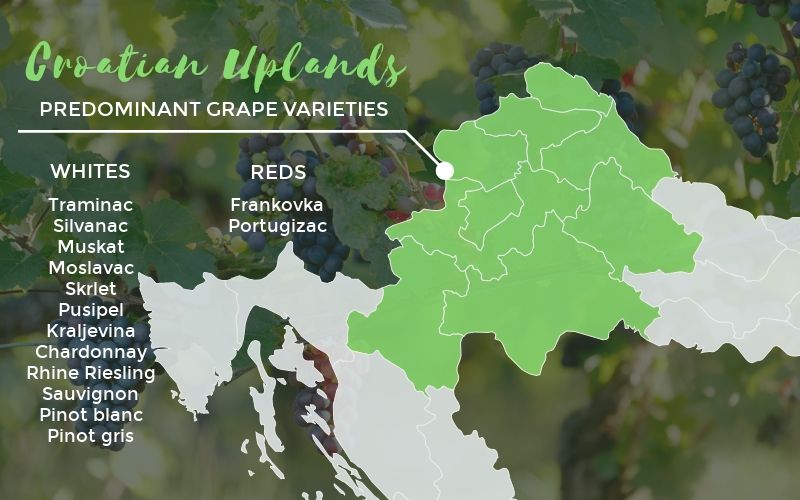
As the northernmost Croatian wine region, in recent years, Zagorje has been pioneering in the domestic production of icewines but the region is also gaining recognition as a producer of some of the finest sparkling wines.
In particular, the area of Pleševica hills is regarded as the next big thing in Croatian winemaking and is today one of the most important spots on the Croatian wine map. Though it has a continental climate, this small Uplands subregion gets a lot of sun and is producing mainly Chardonnay, Graševina, Pinot blanc, Traminac, Riesling and Portugizac.
For more related content on Croatian wine regions, make sure you're following TCN's gourmet page.
The Holy Trinity of Istrian Wine: Refošk
November 29, 2018 - The third and last in a series of articles unveiling the most important Istrian wines.
Choosing the third most iconic Istrian wine was a bit tricky. There is the famous Muškat which can be found in several different styles, though in Istria it is traditionally produced as a dessert wine, and comes as a close second right after Malvazija. When it comes to red wines, the Bordeaux varieties like Merlot, Cabernet Sauvignon, Cabernet Franc, and Petit Verdot show remarkable results in Istrian terroir and so their production is on the rise. In fact, Merlot is today probably more prevalent than Teran.
However, since we're talking about the Istrian "holy trinity," choosing any other variety than Refošk would be a sacrilege. This rich red enjoys the reputation of being the enfant terrible of Istrian wines, and because of its strong, tannic flavor, you either love it or hate it.
Although it was long mistakenly considered that Refošk is merely another name for Teran, and even that they are "first cousins," an extensive DNA analysis and comparison of these two varieties determined that they are actually two separate cultivars, despite their numerous genetical similarities.
According to a renowned Italian professor Antonio Calò and several other wine experts, Refošk is indigenous to northern parts of Italy, namely the Friuli-Venezia Giulia region, and in particular the Karst plateau which stretches across the Italian border to both southwestern Slovenia and northwestern Istria.
Refošk is dark ruby to violet in color; it has a pronounced fruity flavor with a slightly bitter aftertaste and exudes a rich aroma reminiscent of cherries and black currants with a touch of black pepper and vanilla from the wooden barrels. It is best paired with cured meats, especially Istrian game sausages, but also grilled red meat, and traditional dishes like boškarin žgvacet with gnocchi.
In Istria, this powerful, full-bodied red is most often used in various blends while Refošk varietal is a rare gem made only with superb vintages, and very few winemakers have managed to tame its wild nature.
For more related content, make sure you follow Total Croatia Wine.
Second Best in European Union: Croatia Produced 35% More Wine This Year
Croatia is the second best in the European Union when it comes to wine production for 2018. The country produced as much as 35 percent more wine, with only Slovenia producing more in the whole of the EU.
As Miroslav Kuskunovic/Agrobiz/Poslovni Dnevnik writes on the 14th of November, 2018, European Commission (EC) experts have pointed out the fact that this year, faith in the wine sector has been restored after the climate crises that caused enormous concern in the past. Wine production will be be 22 percent more than it was back in 2017, and 5 percent more than the average over a five year period.
Croatia will have production of 777,000 hectoliters of wine this year, which is 35 percent more than last year, but also 23 percent less than the five-year average. The European Commission's estimate is the latest report that strongly suggests that this year, wine production in the EU as a whole will be exceptionally good in comparison to 2017, when it dropped in most countries.
The Commission forecasts that the European Union will have production of 175.6 million hectoliters, which is a significant 22.1 percent more than in 2017, and 5.1 percent more than the five-year average. Croatia is, in regard to those estimates, among the countries to have the most growth in this sector in comparison to 2017. Growth in production from Croatia has been surpassed only by neighbouring Slovenia, with an impressive 57 percent growth.
The analysis explains, as mentioned, that this year has returned faith in the wine sector after the recent production drop which was owing mainly to climatic changes, and production was at record low levels. Although this year there were still some significant climatic changes, especially in Northern Europe with some heavy droughts over summer which even saw the United Kingdom turn from green to brown, all of this had a positive impact on the production of grapes and the extremely good quality of the wine, the experts from the European Union explain.
They note that climate change, as well as disease as a ''complementary'' element in grape production due to frequent rains, frosts, droughts and the like, will have a great impact on the future as well. For this reason, the winemakers will have to apply new technologies and knowledge in grape and wine production, as was highlighted in the analysis.
The fact that Croatia will have an excellent level of wine production this year will be confirmed by some of the country's respected and leading winemakers.
"Compared with last year's grape harvest, the amount of grapes is larger, with a bit more yield. As for wine quality, we expect this year to be the highest,'' said Martina Krauthaker Grgić, from the Krauthaker winery. Sebastian Tomić from the Tomić winery says that in 2018, there was no attack of disease on the grapes.
"I dare say that this is a good year with regard to quality and quantity, that is, the quantity is better by 30 percent," noted Tomić.
"This year was really ideal, better than last year. There was no disease, the weather conditions were remarkable. The grape quality is excellent and we expect outstanding wines, balanced, mineral and full bodied,'' says winemaker Josip Franković.
"This year's vintage was excellent both in terms of quality and quantity, and the first wine from PZ Putniković can be expected on the market in March," says Ana Barać of PZ Putniković.
Want to keep up with more information on Croatian wine? Make sure to follow our lifestyle and Total Croatia Wine pages for much more.
Click here for the original article by Miroslav Kuskunovic/Agrobiz on Poslovni Dnevnik
Could Slavonia be Transformed into Croatian Tuscany?
Could Slavonia become Croatia's very own Tuscany through the story of its local wine? Possibly, as Kutjevo has seen a massive 54 million kuna investment into its new area.
As Poslovni Dnevnik writes on the 11th of November, 2018, on Friday in Kutjevo in Slavonia, a new investment in the Galić winery worth a massive 54 million kuna was presented, the huge investment will increase the winery's capacity by as much as one-third, as they announced.
Of the 54 million kuna, 35 million kuna was invested in the building itself and another 19 million kuna into the equipment. Winery owner Josip Galić pointed out that the winery will remain a boutique winery, and will follow all the current trends, continuing to produce quality wines, rather than focus on mass production.
"Although our winery could be considered a miracle of modern technology and has equipment that even the world-renowned wineries would envy, we're just starting to build our story in Kutjevo. The ultimate goal is to develop the whole region, we want to make a Croatian Tuscany out of Slavonia, as it justifiably deserves it,'' explained Josip Galić, the owner of the winery. The CEO of Galić wine, Andrej Markulin, pointed out that this year, the winery is celebrating ten years of business and wants to intensify its production of "serious" wines in the long run.
The winery in Slavonia looks simply like brick and concrete, but attracts tourists and wine lovers from all over the world, and the attraction is intensified just by viewing the interior and getting to know the equipment that the world's best manufacturers are currently offering.
"With new technology and equipment, we have all the conditions [available to us] to achieve this goal very quickly," he pointed out. The winery began with seven hectares of vineyards and 30,000 bottles of wine. Today, there are 55 hectares, and some of the grapes are from local wine growers.
The capacity of the new winery is 630,000 bottles, which is 30 percent more than there is at the minute, and their annual production is 330,000 litres. In addition to wine production and grape growing, Galić launched chestnut and blueberry growing this year, into which there will be an additional investment of 8.5 million kuna.
Want to keep up with more news like this from Slavonia and from across the country? Make sure to follow our lifestyle and Made in Croatia pages for more.
Encouraging Overseas Statistics See Croatian Winemakers Resort to Foreign Markets
Through the withdrawal of EU money for promotion, Croatia's winemakers have been entering new markets more successfully over the last few years.


